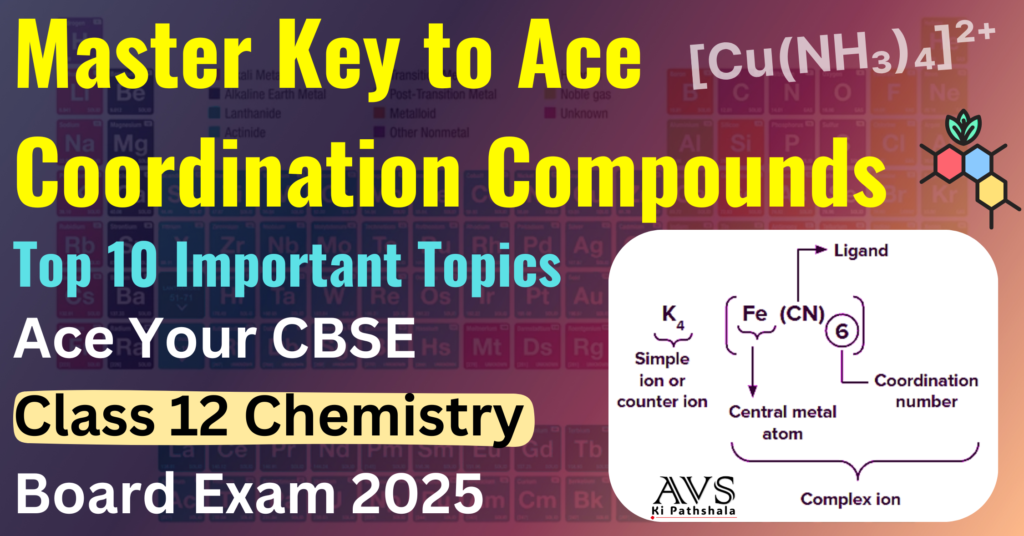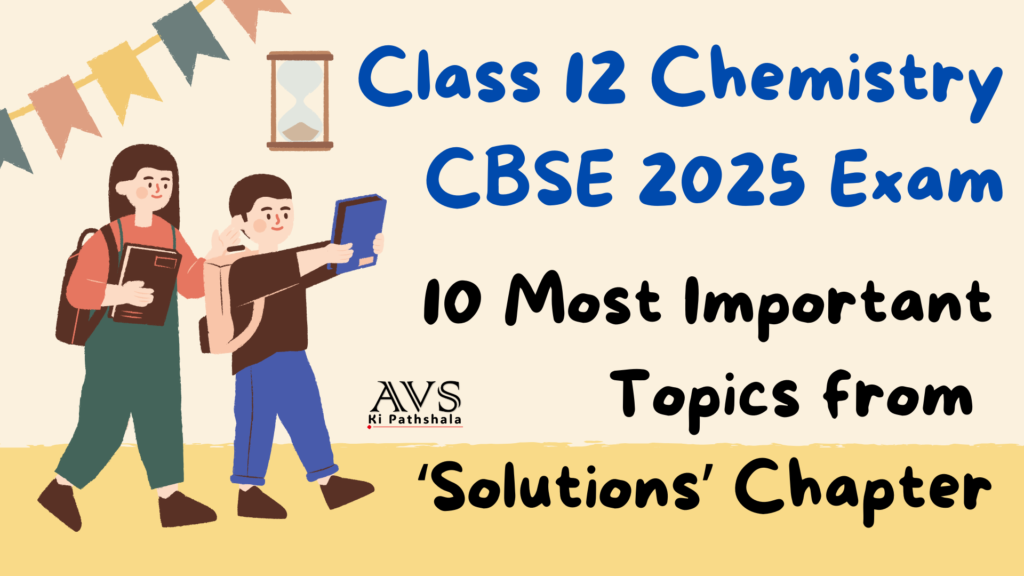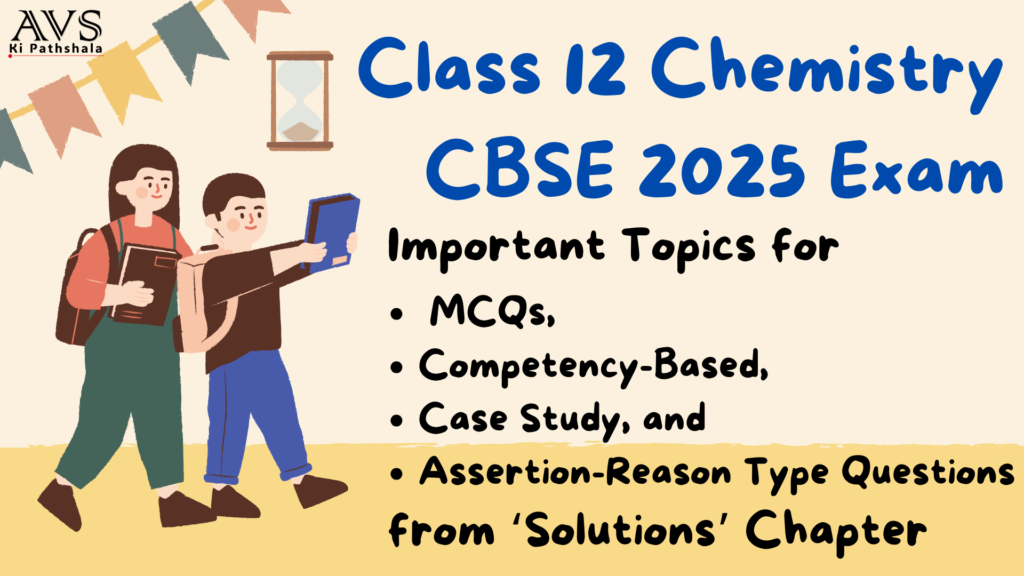Coordination Compounds
Coordination Compounds form an integral part of the CBSE Class 12 Chemistry syllabus. Over the years, questions from this chapter have consistently appeared in the board exams. A thorough understanding of the key concepts is essential not only for scoring well but also for cracking competitive exams like JEE and NEET. This guide lists the top 10 important topics from Coordination Compounds based on past CBSE papers. These topics are prioritized based on their likelihood to be asked in the 2025 board exams, ensuring you’re well-prepared for the big day.
Top 10 Important Topics for 2025 CBSE Board Exam Class 12 Chemistry
1. Werner’s Theory of Coordination Compounds
-
- Type of Question Expected: 2-mark short answer questions, focusing on explaining the theory.
- Key Concept: This theory explains the bonding in coordination compounds, distinguishing between primary and secondary valency.
- Important Definition: Secondary valency refers to the coordination number of the central metal atom.
2. Nomenclature of Coordination Compounds
-
-
- Type of Question Expected: 3-mark questions asking for the correct naming of a compound or writing the formula from the given name.
- Key Concept: Systematic IUPAC rules for naming ligands, oxidation states, and coordination spheres.
- Formula Example: For the compound [Co(NH3)6]Cl3, the correct name is Hexaamminecobalt(III) chloride.
-
3. Isomerism in Coordination Compounds
-
- Type of Question Expected: 3- or 4-mark questions focusing on explaining or identifying different types of isomerism.
- Key Concept: Structural isomerism (ionization, linkage, coordination) and stereoisomerism (geometrical, optical).
- Example: Geometrical isomerism in [Pt(NH3)2Cl2] (cis and trans forms).
4. Valence Bond Theory (VBT)
-
- Type of Question Expected: 5-mark long answer question involving explanation of VBT and application to specific complexes.
- Key Concept: Explains bonding in coordination compounds based on hybridization of metal orbitals and formation of coordinate bonds.
- Example: In [Ni(CN)4]2-, nickel undergoes dsp2 hybridization.
5. Crystal Field Theory (CFT)
-
- Type of Question Expected: 5-mark long answer questions, especially involving diagrams and splitting of d-orbitals.
- Key Concept: CFT explains the color and magnetic properties of complexes based on the splitting of d-orbitals in different geometries (octahedral, tetrahedral).
- Diagram to Study: Splitting of d-orbitals in an octahedral field.
6. Stability of Coordination Compounds
-
- Type of Question Expected: 2- or 3-mark short answer questions.
- Key Concept: Stability of a coordination compound depends on factors such as ligand type, charge on the metal ion, and chelation.
- Important Definition: Chelate effect refers to the increased stability of complexes formed with polydentate ligands.
7. Magnetic Properties of Coordination Compounds
-
- Type of Question Expected: 3-mark questions.
- Key Concept: Paramagnetic and diamagnetic behavior of coordination compounds based on the number of unpaired electrons in d-orbitals.
- Example: [Fe(CN)6]3- is diamagnetic due to no unpaired electrons, while [Fe(H2O)6]2+ is paramagnetic with four unpaired electrons.
8. Applications of Coordination Compounds
-
- Type of Question Expected: 3-mark questions asking for real-life applications.
- Key Concept: The use of coordination compounds in medicine (cisplatin as an anticancer drug), analytical chemistry (EDTA in complexometric titrations), and biological systems (hemoglobin).
- Example: Use of [Ag(NH3)2]+ in qualitative analysis to test for halide ions.
9. Bonding in Metal Carbonyls
-
- Type of Question Expected: 2-mark short answer questions, focusing on bonding features.
- Key Concept: Metal carbonyls are complexes where carbon monoxide acts as a ligand through both σ-donation and π-back bonding.
- Example: Bonding in [Ni(CO)4], a neutral metal carbonyl complex.
10. Coordination Compounds in Biological Systems
-
- Type of Question Expected: 3-mark questions on the role of metal ions and coordination complexes in biological systems.
- Key Concept: Understanding how coordination complexes function in biological processes like oxygen transport (hemoglobin) and photosynthesis (chlorophyll).
- Example: The role of Mg2+ in chlorophyll.
Important Topics for Different Question Types: CBSE Class 12 Chemistry
1. Multiple Choice Questions (MCQs)
These questions generally test basic concepts, quick calculations, and definitions. The following topics are essential for MCQs:
- Werner’s Theory of Coordination Compounds
- Basic questions regarding primary and secondary valency.
- Example: Identify the correct statement about primary valency in a given compound.
- Nomenclature of Coordination Compounds
- IUPAC naming and writing formulas of coordination compounds.
- Example: Choose the correct IUPAC name for [Cr(H2O)4Cl2]Cl.
- Isomerism in Coordination Compounds
- Quick identification of isomers (geometrical and optical).
- Example: Which of the following complexes shows geometrical isomerism?
- Magnetic Properties of Coordination Compounds
- Determining magnetic behavior based on the number of unpaired electrons.
- Example: Identify the paramagnetic complex from the options given.
2. Competency-Based Questions
These questions check how well students can apply their understanding to real-life scenarios and integrate multiple concepts. The following topics are ideal for competency-based questions:
- Applications of Coordination Compounds
- How coordination compounds are used in medicine, industry, and biology.
- Example: A question about the role of cisplatin in cancer treatment or EDTA in water softening.
- Coordination Compounds in Biological Systems
- Understanding the role of metal ions in biological systems, like hemoglobin and chlorophyll.
- Example: Explain the role of Fe2- in hemoglobin’s oxygen-binding process.
- Valence Bond Theory (VBT)
- Hybridization and geometries of complexes in real-world contexts.
- Example: Explain why [Ni(CN)4]2- is square planar while [NiCl4]2- is tetrahedral.
3. Case Study-Based Questions
These questions focus on real-world scenarios requiring in-depth understanding of multiple topics. The following topics are frequently used for case study-based questions:
- Crystal Field Theory (CFT)
- Case studies on the color and magnetic properties of transition metal complexes based on d-orbital splitting.
- Example: A case where the color of a complex is discussed, requiring students to explain the splitting pattern of d-orbitals.
- Stability of Coordination Compounds
- Questions based on factors affecting stability, such as the chelate effect, charge on the metal ion, or ligand field stabilization energy.
- Example: Analyze the stability of a coordination complex used in industrial catalysis.
- Bonding in Metal Carbonyls
- Case studies focusing on the industrial applications of metal carbonyls.
- Example: Analyze the bonding in [Fe(CO)5] and its use in catalysis.
4. Assertion-Reason Type Questions
These questions require students to evaluate statements based on cause-effect relationships. The following topics are crucial for assertion-reason questions:
- Crystal Field Theory (CFT)
- Questions on the splitting of d-orbitals, spectrochemical series, and magnetic properties.
- Example: Assertion: [Fe(CN)6]3- is low spin. Reason: CN– is a strong field ligand.
- Isomerism in Coordination Compounds
- Assertion-reason questions on geometrical and optical isomerism.
- Example: Assertion: [Co(NH3)4Cl2]+ has two geometrical isomers. Reason: It has a square planar geometry.
- Werner’s Theory
- Assertion-reason based on the distinction between primary and secondary valency.
- Example: Assertion: Primary valency corresponds to ionizable bonds. Reason: It is satisfied by anions.
Conclusion:
Coordination Compounds is a high-yield chapter with a broad range of conceptual questions appearing in the CBSE exams. From Werner’s theory to the applications in real life, it offers a perfect blend of theoretical and practical knowledge. As you prepare for the board exams, focus on understanding core concepts such as isomerism, hybridization, and the role of coordination compounds in biological systems. Diagrams for crystal field splitting and magnetic properties are often examined, so practicing them is crucial. With consistent practice, mastering these topics will ensure success in the 2025 CBSE Chemistry exam.
By focusing on the right topics for each question type, students can enhance their exam preparation. MCQs typically revolve around straightforward concepts like nomenclature, isomerism, and basic properties of coordination compounds. Competency-based and case study questions demand a deeper understanding of real-world applications, such as metal ions in biological systems and stability factors. Assertion-reason questions often focus on conceptual clarity and the relationships between different aspects of coordination chemistry, like magnetic properties and bonding theories. Preparing in this focused manner will equip students to tackle all types of questions confidently in the 2025 board exams.
Important Points to Remember:
- Pay special attention to IUPAC nomenclature and isomerism, as these are frequently asked.
- Practice drawing the splitting of d-orbitals in octahedral and tetrahedral fields.
- Be familiar with real-life applications of coordination compounds, especially in medicine and biology.
- Understand the difference between paramagnetic and diamagnetic behavior in complexes.
This structured preparation strategy will help you excel and give you a strong foundation for other competitive exams as well!
To enhance your preparation even further for CBSE 2025 Exam, you can also connect with us on YouTube, where we will guide you through all these topics in a comprehensive manner. To join us on YouTube, simply click the link below, and you’ve already taken your first step towards scoring better marks.
In the next post, we will discuss the key topics of the chapter ‘Haloalkanes and Haloarenes’.
Note: All the topics covered in this article are based on the “Coordination Compounds” chapter of Class 12 Chemistry CBSE Board and have been curated after analyzing previous years question papers. This article can be helpful for students aiming for success in exams, but it’s also important to thoroughly understand the entire syllabus and practice regularly.
Best wishes to all students!
Thank you!





